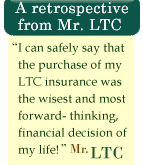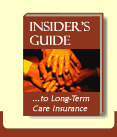An Interview with Robert L. Pearson
by Mr. LTC
Robert L. Pearson is president and CEO of Wisconsin-based CareQuest, which he founded in 1991. The company evolved from a long-term care assistance program that he created for government agencies. In the mid-80s, Pearson worked with the U.S. Health Care Financing Administration on proposals to develop educational initiatives for Medicare beneficiaries regarding TEFRA Risk Contracted HMOs. During this time he founded Future Financial Resource Group, a firm which specialized in insurance products for the elderly.
Mr. LTC: Robert, I see that you have something new called Bridge-Link. What's this about?
RP: We just introduced our new Bridge-Link concept; we haven't even advertised it yet. Bridge-Link presents a solution to the problem (of how to handle the growing mass of people who need to arrange for long-term care) that government talks about but hasn't put anything in place yet despite all the talking. Bridge-Link literally examines all of the problems - related to service delivery, financing, the caregiving element - which is huge, with all problems associated with that - also the geographic mix of families, in which everybody's moving, husbands and wives work, we're moving toward a society with more parents than children. Bridge-Link identified all the problems and we came up with a solution - not a fix. Bridge-Link creates a process starting with the employer. mrltc: Why does the process start with the employer?
RP: Most of the benefits we've relied on, such as health care, have generated from our employment.
Mr. LTC: What's your agenda when you go to an employer?
RP: We found there's a big problem. We found out when we go into an employer, we're interested in bringing message to the employees' parents. Most employees don't communicate this great stuff with their parents. Bridge-Link links the employee to the employer and bridges the educational process to the parents. We communicate with parents. We educate them. The kids love it.
Mr. LTC: Why would an employer or association want to work with you over another firm ?
RP: We don't just supply a list of caregiving resources. Our core element - our competency - is long term care and eldercare assistance, not in the service giving side of the industry but helping people find services. We go much further than a referral network could do. We go into the workplace and say, we're going to help maintain and maximize productivity when an employee deals with eldercare, and we know that on average in this country, employers lose about $3,000 dollars a year in employee productivity. Most comes from employees who are preoccupied while at work - long lunches, phone calls, worry. Through the Bridge-Link process, with one call the employee takes care of the problem. They can call after work; before work is OK, too.
mrltc: What's an example of a Bridge-Link service that's unusual?
RP: We'll send an assessment nurse anywhere to give an assessment of patient. It's need based: to give people help, we do care planning. We'll do a 45 minute intake with people who need caregiving or with the caregiver, then, working independently and unbiased, we try to find the most suitable and dignified setting for each patient at a cost they can afford. We will assemble everything; we'll do everything we can possibly do. Our staff are master's degree social workers. We have a staff in Madison, WI, a lot from the University of Wisconsin system.
mrltc: Where do you get the information you use to link people and services?
RP: We have our own research division, updated daily. We don't accept money to be listed in our database, we don't even accept calls from providers unless they're just making sure they're on the database. We work with insurance companies on one side, but they don't dictate how we approach our service. We are independent from insurance companies. We have a million resources in our data base: caregiving and support groups, license facilities, nursing homes, home chore services, home repair, meals on wheels, to name a few.
mrltc: What makes your services unique?
RP: CareQuest is a work and family assistance program, uniquely different. We create a solution involving both the profit side and the other side. When you really dig in deep in this (long-term care) industry and you see the problems, it changes your views rapidly. It's sometimes difficult when we work both sides, but we can't worry about stepping on anyone's toes. Insurance companies are important, but insurance doesn't solve everything. Resolving long term care issues is not a product but a process. We've brought in all the appropriate components and figured how to deliver it and educate everybody on both of the two sides: caregiving on one side, financing on the other. And the important parts in both sides are education, care planning, even planning early for caregiving in the same way we do for retirement. We discuss long term care financing, then discuss delivery, then we discuss liabilities.
mrltc: How do you interface with financial planning professionals?
RP: We have created an educational program in which we teach them what kinds of care planning options people should consider towards financing. We make this process available to professional benefit representatives who want to bring this to their clients and prospects. They go through special training at Care Quest University; they leave with professional designation. This is not a home study course, it's a Milwaukee campus course. The reps who deliver the Bridge-Link process to employers and associations need to understand how it works.
mrltc: How did you get interested in caregiving? PR: The majority of my career was in health care finance. I saw it evolving. "Wait!" I said to myself, "What's going to happen when?" Since the early 1980's I've been looking at that and I wanted to be involved in it.
mrltc: How did you start CareQuest?
RP: In 1985 we started collecting data. There was no managed care then. Everybody was put in the hospital for anything. It was up to the doctor, and there was a lot of incentive for doctors and hospitals to have all those patients in there. There was a lot of hospital expansion, and mostly because Medicare beneficiaries were using hospital services. Patients went in overnight for cataract surgery, as an example. People sometimes stayed in the hospital for one to two years. Senator Claude Pepper, in one of the 1970's crises, said to the insurance industry, you've got to help us, Medicare isn't giving enough coverage in hospitals (they only gave 150 days of coverage then). Medicare Supplements came out, and the coverage increased finally to unlimited. In 1983, they decided hospital costs were out of control, inflation was rising, and they wanted to contain hospital costs. So they came up with Diagnostic Related Groups (DRG's ) - 426 reasons why someone should stay in a hospital. Today there are more categories. Also, the Prospective Payment System (PPS) approach to reimbursement established the number of days the patient could stay in the hospital. Faster discharges and outpatient treatments increased 10- fold. Ted Koppel's Nightline in 1986 covered the issue. I found it very intriguing. I saw the discharge rates going up; people were being discharged much quicker and much sicker. People didn't have a lot of resources. Nursing homes were for chronically ill people. We didn't understand home health care, didn't have group homes, assistive living facilities, home health care was just coming out. We decided to go out and start collecting data about all the people willing to offer service to an individual. We created the first data base - an entry database into the long term care industry on a national basis. We compiled data, sold lists, made the lists available to long term care agents and companies, we started approaching government agencies with an information and referral service. And we thought we'd go to business and government agencies and sell them on the concept that if an employee had a problem with a parent, they could call us and get information in a certain area. It's called an information- based approach to helping a caregiver with another caregiver or caregiving situation. The problem was that information was becoming readily available - what we had collected was great but our marketing had to change. Information and referral was not really helping. Now what? We decided in 1992 that we would get away from the information-based approach and go into a needs-based approach, to solving a problem.







